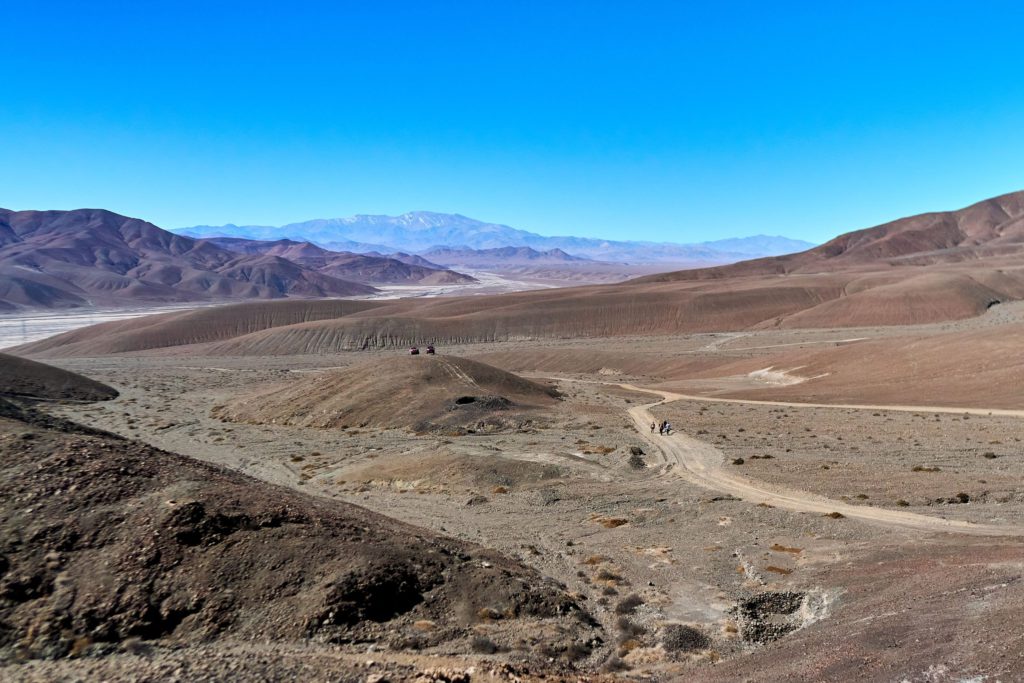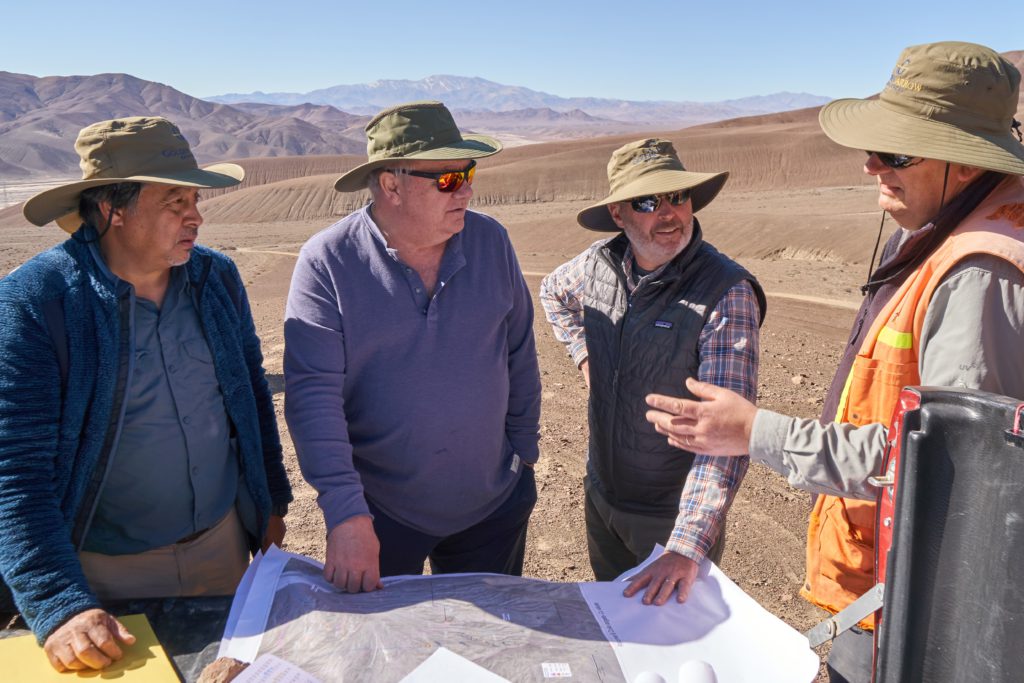JV Article: Golden Arrow’s San Pietro project is in the heart of Chile’s ‘mining mecca’


When Golden Arrow Resources (TSX: GRG; US-OTC: GARWF) learned that Japan’s Sumitomo Metal Mining wanted to exit Chile and was putting its San Pietro copper-gold-cobalt project on the market, the Canadian junior explorer had the wherewithal to pounce.
Flush with cash from the sale in September 2019 of its Chinchillas silver mine to SSR Mining (TSX: SSRM; NASDAQ: SSRM; ASX: SSR) in a cash-and-shares deal valued at $44 million, Golden Arrow put in a bid that, quite frankly, management says, it didn’t expect to win.
“I didn’t think we stood that big a chance of getting it and I was shocked when they called us back,” Brian McEwen, the company’s vice-president exploration and development, recalls.

That’s because the iron-oxide copper gold project, 100 km north of Copiapo, a mining district that is home to all the major iron oxide copper gold (IOCG) in Chile, is also immediately adjacent to the west of Capstone Copper’s (TSX: CS) Santo Domingo mine development project and 10 km northeast of Capstone’s producing Mantoverde mine.
“There are mines everywhere you look and geologically, it is the spot, at least as far as IOCG deposits are concerned,” McEwen says. “Lundin Mining and Sumitomo’s La Candelaria, CMP’s Cerro Negro iron mine, and of course Capstone’s Mantoverde and Santo Domingo. They are all through there. It’s the mining mecca.”
While there were several other bidders for San Pietro, McEwen explains, Sumitomo only wanted payment in cash, and Golden Arrow was able to capitalize on its strong treasury and could deliver the US$3.35-million sticker price with no strings attached in March 2022.
“We were just thrilled,” he says. “The project came with a lot of past work. Sumitomo had drilled some 80 holes, and did geophysics, and Teck before that. They had put it on the shelf in 2012 and nobody had really looked at it since.”
The San Pietro project has an extensive database that includes about US$15 million in historic exploration work. That work involved over 34,000 metres of drilling, more than 1,000 surface samples and multiple geophysical surveys, which have been compiled to identify four main target areas.
The Rincones target, the focus of the historic work, has returned drill hole assays with significant copper, gold and cobalt values, including: 1.14% copper, 0.12 g/t gold, and 335 parts per million (ppm) cobalt over 28 metres starting at 236 metres downhole in RA12DH-003; 1.2% copper, 0.21 g/t gold, and 579 ppm cobalt over 34 metres starting at 370 metres downhole in RADH-02; and 1.25% copper, 0.32 g/t gold, and 70 ppm cobalt over 36 metres starting at 18 metres downhole in RARC-17. Another historic hole returned 0.76% copper, 0.13 g/t gold, and 146 ppm cobalt over 20 metres starting from 250 metres in RA12DH-002.
“When this was looked at in the past, metal prices were quite a bit lower and they had never considered the cobalt,” McEwen says. “When we went in and looked at the cobalt, we got some great numbers on the potential.
“We have some very high cobalt intersections close to surface that might be very attractive to Capstone’s cobalt plant,” he adds. “On one level, all we really need to do is prove our ore is cheaper than their ore.”
It’s a plan that worked for them at Chinchillas, he says, noting that Golden Arrow’s goal at that time had been to show SSR Mining that ore from Chinchillas needed to go to their plant, 40 km away, “and that we had higher-grade ore than they did remaining at Pirquitas.”
In January the company completed an IP-resistivity geophysical survey – the final drill targeting work prior to the company’s drill program, which kicked off in the first week of February. Golden Arrow has budgeted up to US$7 million for up to 20,000 metres of exploration drilling at the 184.5-km2 project. The phase 1 drill program will consist of seven holes for a total of 2,650 metres into the key targets: Rincones, Colla, Rodeo and Radiss Norte. The first phase of drilling will test several new interpretations that resulted from the recent field programs to fine-tune targeting for the subsequent holes.
Over the last seven months, Golden Arrow, a member of the Vancouver-based Grosso Group of companies, has modernized and added to the database to refine the targets for additional drilling. The work included detailed (1:2,000 scale mapping) covering more than 10 km2 at Rincones and Colla, plus surface sampling, relogging of the most significant drill holes, a re-assessment of the historic geophysical surveys and a 3-D IP/resistivity survey at the Colla target. In the process, the field team added a fifth zone, Mariposa, to its list of priority targets.
“The past drilling was extensive, and historic prospects are very exciting, but after reviewing the old database we still had a lot of questions,” McEwen says. “The detailed field programs we completed in 2022 and earlier this year have resolved many questions, led to some new interpretations, and already identified new areas of mineralization. This first small stage of drilling is going to test the models at several targets, which will then set the stage for the larger program through the remainder of the year.”
At the Rincones target, two holes will be drilled in the area of the best historic copper intercepts to test a new geological model for the magnetite mantos and copper mineralization.
Golden Arrow will drill two holes into the Colla target, 2.3 km southwest of Rincones, to test specularite breccias and magnetite mantos delineated at surface by the new detailed mapping. Colla spans 2.3 km of the northwest structure that the company believes may connect from the Rodeo target, 5 km away.
Colla hosts the best cobalt intervals from historic drilling. Only four historic holes were ever drilled and all showed cobalt mineralization over a strike length of 2.2 km. Highlights included 626 ppm cobalt over 10 metres from 211 metres downhole in CO-11-DH-001; 32 metres of 414 ppm cobalt from 116 metres in hole CO-11-DH-002; and 364 ppm cobalt over 12 metres starting 36 metres downhole in C012DH-001.
One hole is planned at the Rodeo target, 7.5 km to the north of Rincones. Historic intercepts at Rodeo included 34 metres of 1.03% copper and 334 ppm cobalt in drill hole R012-005.
At Radiss Norte, 2.7 km north of Rincones, historic drilling returned 276 ppm cobalt over 58 metres starting at 29 metres downhole in RADDH-01; 269 ppm cobalt over 27 metres from 69 metres in hole RA13DH-004; and 306 ppm cobalt over 29 metres from surface in RADDH-05. Golden Arrow will start with one hole at Radiss Norte to test the extent of the surface mineralization and test for other deep mineralized breccias.
Another hole will be drilled at the company’s newest target, Mariposa, to test the extent of mineralization at surface. Mariposa sits at the northeast corner of the project, and hosts a series of specularite veins outcropping in a 200- by 80-metre area of copper oxide mineralization.
Mineralization at San Pietro is typical of an IOCG system, with copper-gold-iron-cobalt minerals in breccias, veins and mantos within a zone of potassium-feldspar-chlorite alteration. The structures are rich in magnetite and specularite and in some cases associated with calcite and were mainly developed along northwest-southeast lineaments.
The project is east of the Atacama Fault system, a major north-south regional structure, which Golden Arrow says was instrumental in controlling the emplacement of the deposits in the area.
San Pietro has a paved highway and two powerlines that cross the property, as well as easy year-round access, is at a low altitude and is just 8 km from the town of Diego de Almagro.
“We have a lot of peoples’ attention now – including Capstone’s,” says McEwen. “I believe lots of people are going to be watching this drill program.”
The preceding Joint Venture Article is PROMOTED CONTENT sponsored by Golden Arrow Resources, and produced in co-operation with The Northern Miner. Visit www.goldenarrowresources.com for more information.
Comments